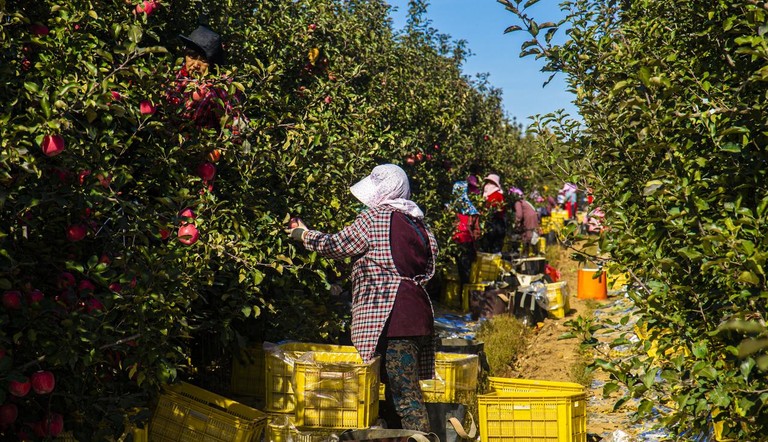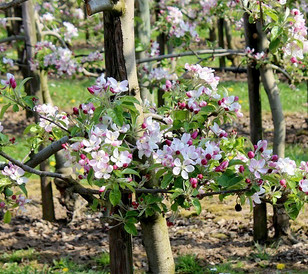
Changing climate and the potential risk for fruit growing

Global temperatures have already risen by an average of 0.5°C-0.7°C since the late 1800s and that trend is expected to accelerate in the next 100 years, as the release of greenhouse gases continues. Forecasts suggest that temperatures could rise by 0.2°C every 10 years over the next century and that this could have severe implications for fruit growers.
For fruit trees, it is essential for temperatures to drop in late autumn and winter (‘chilling’) to promote the dormancy phase in the annual growth cycle. Outwardly buds appear dormant, despite the cold, however, processes in the bud continue, very slowly, in the cycle of flower development as a prerequisite for flowering in spring. From a production viewpoint, the delay in spring bud break and flowering brought about by chilling is vital for most perennial fruit crops. Despite this, the extent to which chilling is important, depends on the genetic traits of the cultivar, for example, later flowering types requiring a great chill accumulation prior to bud break.
This accumulation phase, ‘the chilling degrees’, by the buds occurs when temperatures are generally between 2°C and 7°C and it enables flowers to develop which have the capacity to set and retain fruit. It also provides a defence mechanism which has evolved to avoid flowering occurring at time which climatic damage (e.g. freezing temperatures) has a high probability of occurring; it also synchronizes flowering within the tree and a cultivar and between cultivars.
Without chilling, floral bud development can be sporadic, or early, occurring at a time when the climate is less suitable for pollinators and the processes of flower fertilization. It may also be that the flowers are produced so early they miss the emergence of the bulk of pollinator population altogether, again hampering fertilization and potential fruit growth. Flowering synchronization is also highly important in commercial fruit production, influencing maturity, harvest date and storage.
It is not only the synchronization of flowering within and between cultivars and varieties that chilling promotes, it also impacts on ‘flower quality’. Abnormal, or low chilling can promote the production of flowers which have less chance (‘low quality flowers’) of setting and retaining fruit.
The threat to yield, fruit quality and economic sustainability of production, from rising global temperatures is, therefore, significant for fruit growers. In countries where apples are grown in higher mean temperatures, like Australia and South Africa and parts of the USA, varieties are grown which have a lower chilling requirement and are less dependent on the chilling period.
As average global temperatures continue to rise, variety choice and knowledge of how the cultivar performs in differing conditions will become more important for all growers.
If they do not adapt they will not be able to continue to deliver good yields of quality fruit in a changing climate. But more significant shifts in the industry may be necessary in the long run. In Europe, research has shown that every 1.5°C increase in average temperature is equivalent to a 50-80 km move south. Over time apple and pear production sites may have to migrate to more northern latitudes in a bid to secure cooler winters.
In some parts of the world such as areas of North and South America apple and pear crops are being grown at higher altitudes to capitalize on the consistence and lower risk of not achieving enough chill in the winter months.
But it is not just the winter temperature that will result in management changes. The impact of hotter summers and more sunshine hours need to be considered. Tree fruits have a genetically-fixed development and maturation process linked to the amount of heat received after flowering. That means higher average temperatures will cause fruit to mature more quickly. This has implications for variety choice and affects harvest dates and storage issues.
Traditionally, apples and pears are harvested in the autumn months. This practice can now no longer be ruled by the rigour of calendar dates. As the summers, and winters, have become warmer the seasons have lengthened, across Europe, through early springs and later autumns, and fruits are ripening earlier.
To maintain fruit quality and its link with the most appropriate storage regime, it could become increasingly necessary to focus more on determining when the fruit is ready to be harvested, rather than sticking to traditional dates. Harvest may have to begin in the summer months if the fruit is at the optimum picking time (e.g. long-term storage). Variety selection is once again key with some types having much longer growing seasons that would be better-suited to the changing climate. Climate change can provide opportunities to grow cultivars which benefit, quality-wise, from longer warmer summers.
Undoubtedly there will be issues for cold storage which could become more costly to run with outside temperatures being higher both through early harvesting and the rise in temperatures per se.
The possible increase in sunshine hours also brings a risk of sunburn which can cause significant crop losses. In the future, growers may need to make additional investment in equipment to control or protect the skin of exposed fruit using evaporative cooling equipment or sunburn protectants.
Evaporative cooling can be achieved by spraying fruit with water from over-tree sprinklers. The water evaporation from the skin allows the apple to lose the potentially damaging heat from its skin, reducing the risk of sunburn. Other techniques include shade netting or spray-on products to block sunlight. Spray-on suspensions of small, clay or calcium carbonate particles or wax emulsions create a film that provides some protection from the damaging effects of sunlight.
To read further about the effects of climate change to fruit growers click here.
Flowering synchronization is important in commercial fruit production, influencing maturity, harvest date and storage
Bud on an apple tree in winter
With warmer seasons fruits are ripening earlier
Harvest may have to begin in the summer if the fruit is at the optimum picking time
